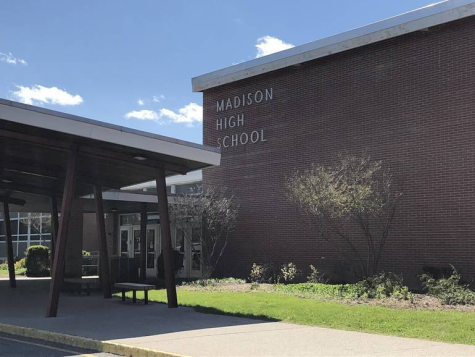Madison High School Makes Late Attempt to Return to Normalcy: Is Now the Right Time?
Madison High School (NJ) current schedule pictured above new schedule set to be implemented on April 5, 2022
On March 13, 2020, students and parents of students at Madison High School, in Madison, New Jersey, received news from Principal David Drechsel on behalf of the school board. After a week of deliberation, the school district notified its community that it would begin to transition to a virtual learning system. This shift in the learning environment came in response to the ongoing Covid-19 pandemic which, at the time, was ravaging downstate New York. While Madison had not yet reported a positive test, the virus found its first New Jerseyan patient ten days prior. Out of an abundance of caution, the board decided to follow neighboring schools’ leads and implement virtual learning for the time being.
Two years, eighteen days, and according to roesnet.org, 2,478 total positive cases later, the small North-Jersey community is still attempting to redirect its course in a world that is moving to recover from the virus that halted society. The first of many changes for the 2021-22 cycle was announced prior to the school year, that being the reinstatement of in-person learning without a virtual option. Since then, the state has approved an exception to the school mask mandate for students in music classes, increased autonomy for schools in establishing their own Covid safety protocols, and, more recently, an end to the universal, public-school mask mandate.

The most recent change in Madison, however, has nothing to do with state guidelines. On March 18, 2022, Madison High School announced an amendment to the 2021-22 altered schedule. The original schedule saw school begin at 7:45, a 15 minute “common break” in place of lunch, and an open block at the end of the day from 1:45 to 2:40 for students to attend music lessons, receive extra help from teachers, eat lunch if the 15 minute break did not suffice, or leave school at any point. Early on in the school year, the break was lengthened to 20 minutes to provide more time for students to receive their free government-provided school meal and eat before their next class. The amended schedule, set to be implemented on the 5th of April, would see the break lengthened yet again to 30 minutes, featuring a rebrand from “common break” to “common lunch.” The change, however, will come at the expense of a 1:57pm end-time as opposed to the 1:45pm end that students have gotten used to. This all begs a few questions. First, is this change necessary? Second, is this really coming at the right time?

As far as the first question goes, there is plenty of evidence for the affirmative. Not only were long lunches prevalent in schools for years prior to the pandemic, there is evidence that they are more environmentally friendly. According to a report referencing various studies, compiled by King County officials in Washington State, longer lunch periods in K-12 schools give students more time to eat and digest a full, balanced meal which can maintain physical health and facilitate cognitive growth. Additionally, lunch serves as a time for many students who otherwise would be without a break from learning in their schedule to relax and unwind, helping to alleviate stress. The report cited Arundel High School in Maryland as an example of one place that employs an extended lunch period, 50 minutes in this case. Since implementing the longer lunch, the district has seen higher average grades among students. So, do students deserve a lunch period that is longer than 20 minutes? Based on what these studies have revealed, that would be a resounding yes. The second question, however, is a bit trickier to tackle.
The recent schedule modification comes at a curious time for Madison. April 5th is set to be the beginning of the fourth and final marking period. With this, students can expect a much higher workload in their classes, as teachers attempt to fit in whatever curricular work is yet to be taught before the end of the year. This is even more extreme in the case of AP classes which must teach all remaining material as outlined by the College Board before AP exams in the first two weeks of May. While consistently long lunches have proven to assist students in the long run, such a sudden shift at as precarious a time as this could very well do the exact opposite, as stripping away that consistency may be just a bit too jarring for students as things heat up coming down the stretch. With that in mind, the benefits of a long lunch could be enough to offset the initial shock from the abrupt modifications to the timetable.
So, is this the right time to change things, or is ten additional minutes just a bit too little too late? That all remains to be seen. Until then, it will certainly be interesting to see how things play out and how students are able to adapt to the unexpected readjustment.
